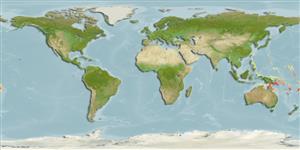Actinopterygii (ray-finned fishes) >
Perciformes (Perch-likes) >
Plesiopidae (Roundheads) > Plesiopinae
Etymology: Assessor: Latin, assessor, -oris = the person that tkes part in some play.
Environment / Climate / Range
Ecology
Marine; reef-associated; depth range 5 - 20 m (Ref. 9710), usually 5 - 20 m (Ref. 27115). Tropical; 24°C - 26°C (Ref. 27115), preferred ?
Western Central Pacific: Great Barrier Reef and Papua New Guinea.
Size / Weight / Age
Maturity: Lm ? range ? - ? cm
Max length : 6.0 cm TL male/unsexed; (Ref. 90102)
Found near reefs (Ref. 7300). In aggregations in caves, often upside down. Males incubate the egg mass in their mouths (Ref. 9710). Also found in caves, crevices and under ledges (Ref 90102).
Life cycle and mating behavior
Maturity | Reproduction | Spawning | Eggs | Fecundity | Larvae
Eggs are guarded by the male parent (Ref. 205).
Paxton, J.R., D.F. Hoese, G.R. Allen and J.E. Hanley, 1989. Pisces. Petromyzontidae to Carangidae. Zoological Catalogue of Australia, Vol. 7. Australian Government Publishing Service, Canberra, 665 p. (Ref. 7300)
IUCN Red List Status (Ref. 115185)
CITES (Ref. 94142)
Not Evaluated
Threat to humans
Harmless
Human uses
Aquarium: commercial
More information
ReferencesAquacultureAquaculture profileStrainsGeneticsAllele frequenciesHeritabilityDiseasesProcessingMass conversion
Tools
Special reports
Download XML
Internet sources
Estimates of some properties based on models
Phylogenetic diversity index (Ref.
82805): PD
50 = 0.6250 [Uniqueness, from 0.5 = low to 2.0 = high].
Bayesian length-weight: a=0.00468 (0.00176 - 0.01245), b=3.18 (2.95 - 3.41), in cm Total Length, based on LWR estimates for this (Sub)family-body shape (Ref.
93245).
Trophic Level (Ref.
69278): 3.4 ±0.2 se; Based on size and trophs of closest relatives
Resilience (Ref.
69278): High, minimum population doubling time less than 15 months (Preliminary K or Fecundity.).
Vulnerability (Ref.
59153): Low vulnerability (12 of 100) .
